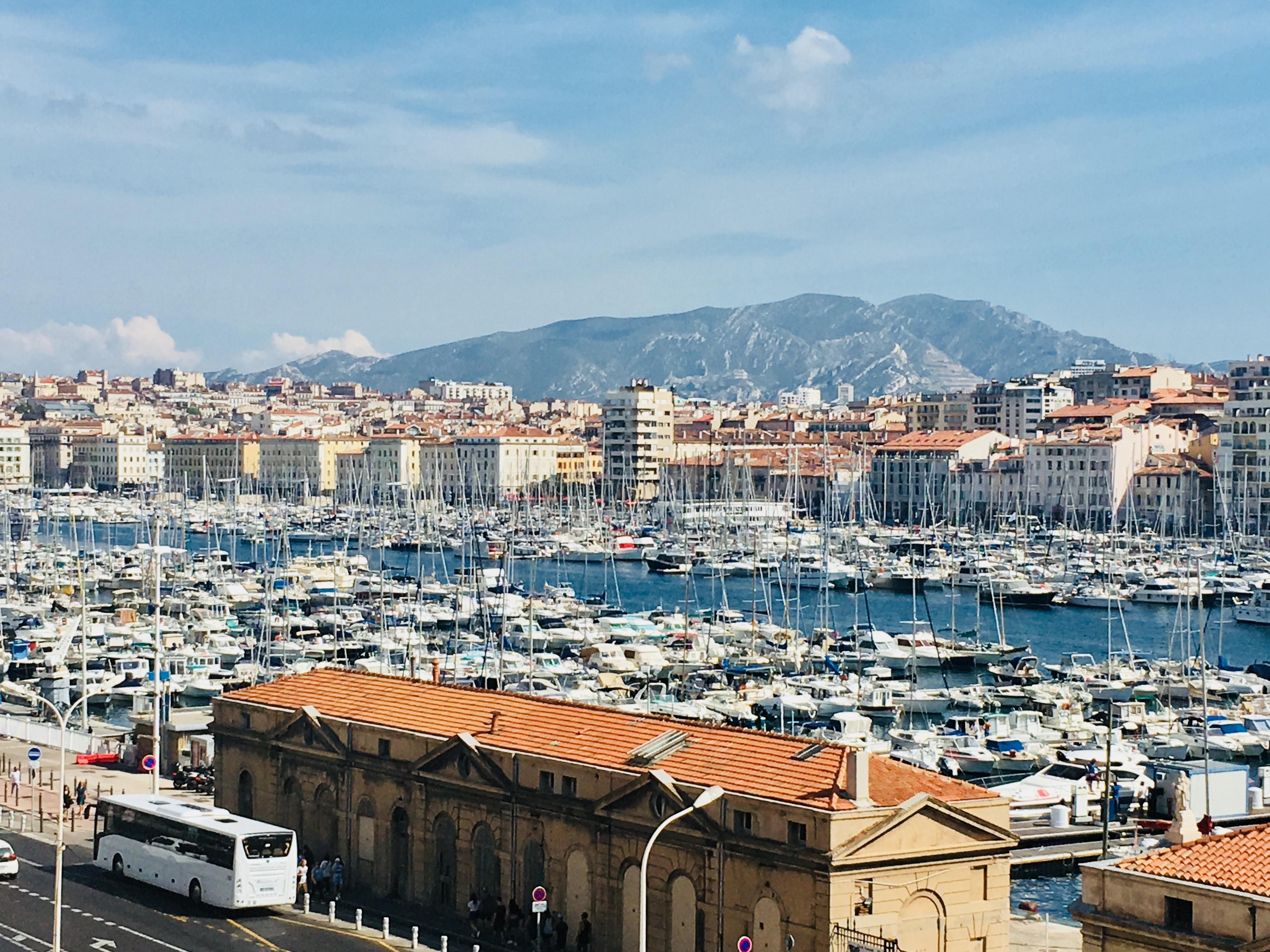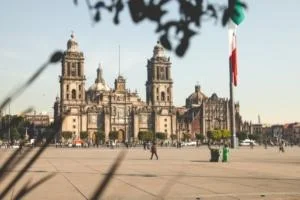Like many cities in the Mediterranean, the city of Marseille has a complicated past. The city is the second-largest one in France and one of the largest in Europe with a history dating back to 600 BC. The city was founded as a Phoenician colony and then a Greek one and because of the city’s major port area, it is one of the most diverse cities in the Mediterranean. After the second world war, the population grew even more considerably with migrants coming from Italy, Spain, and many of France’s then African colonies but if your idea of Marseille is a sleepy village and Provencales cliches, you’ll be sorely mistaken.
Marseille is a city that while baked in the Mediterranean sun, is full of life, and has thriving markets and public spaces to the natural land protected areas, jagged cliff sides, azure-blue beaches, a booming nightlife, and amazingly delicious seafood. Check out some of the best places around the city of Marseille and experience the real beauty of southern France.
Explore the Old Port
The port of Marseille is one of the biggest in the country and one of the biggest in Europe. The massive rectangular port has been there for over 2600 years mostly used as a hub for trade and commerce amongst the various city-states found along the Mediterranean. The Old Port (the Vieux Port) to this day is really more of a neighborhood in its own right rather than just a landmark in the city.
The Old Port is also a central spot for other tourists, especially during the summer months. The port is surrounded by three quays with broad promenades that are constantly bustling with buskers, shops, restaurants, and cafes. Grab a pastis and take in the sunset or do a little dining on some fresh seafood and take in the local music and scenery of the yachts and boats pulling into the docks. The 18th-century warehouses that line the quays give the area a distinctive flair that adds personality to the area, making you feel like you’re taking a little trip through time.
Hop on a boat and explore the Château d’If
Located just a short ferry ride away are the Frioul Islands. The island archipelago includes the islands of Pomègues, Ratonneau, and Tiboulen. The Mediterranean waters are blue and the sights are some of the best as you can look out onto the city from the water. The islands themselves have coves to discover, sandy beaches, and a microclimate that is unique to the area allows for rare and beautiful flowers, plants, and trees to flourish.
Amongst the Frioul Islands is the legendary Château d’If. The “Château” was built initially not as a castle but as a fortress to defend the city of Marseille and while it was never used in such a way, it did get converted to a prison. The notorious nature of the prison continues in the public consciousness to this day through Alexandre Dumas’s The Count of Monte Cristo in which the protagonist Edmund Dantes gets sentenced to, and subsequently escapes from the Château d’If. The prison on the island bears similarity to Alcatraz and is a popular tourist attraction with a dungeon room dedicated to Dantes character. Marc Twain visited the site before it was opened to the public and the Château d’If is listed as an official historic monument by the French government.
Take a tour of the Basilique Notre-Dame de la Garde
The Basilique Notre-Dame de la Garde is the symbol of the city. While Paris has the Eiffel Towel, Marseille has Basilique Notre-Dame de la Garde. The Catholic cathedral sits on a hill overlooking the city and it’s hard to ignore.
The cathedral sits on a hilltop location and in the middle ages, the spot was used as an observation point. Then a smaller cathedral was built here and was a popular pilgrimage destination for much of the medieval era. Finally, in 1853 they built the monolithic building that currently stands there today. While many legendary European cathedrals are centuries old, and Marseille is definitely an old city, Basilique Notre-Dame de la Garde is relatively young in comparison. The church is designed in a grand and opulent neo-Byzantine style using both light and dark marble and amazing gilded cupolas. The church remains an important place for pilgrimages as well as sightseers and architecture lovers.
 Head to the Basilique Notre-Dame de la Garde. The Symbol of the city.
Head to the Basilique Notre-Dame de la Garde. The Symbol of the city.
Explore the colorful streets of Le Panier
Located above the Old Port area along the hillside is the colorful and eclectic neighborhood of Le Panier. Translated as “the basket” in English, Le Panier has been the historic heart of Marseille since 600BC when it was a Greek colony known as “Massalia”.
The neighborhood is known for its colorful buildings, winding cobblestone streets, and narrow alleyways. The area was once the home for many newcomers to the country and historically been a poorer residential neighborhood which often offered visitors a glimpse into local life without the overly clean and “done up-ness” of areas dedicated to tourism. While the area in recent years has been a little gentrified Le Panier has tons of bustling boulevard with boutique shops, quaint cafes, museums, and some of the best Algerian food in the city. Le Panier also has several landmarks worth checking out like the Vielle Charité, La Canebiere, and the Cathédral de la Major.
La Vieille Charité: Located on Place des Moulin one of the most important landmarks in La Panier is the Vieille Charité. The building was built in 1640 and was built and financed by the city to give the poor of the area a place to stay in compliance with a royal decree to contain the homeless. The space became important for the foundation of the city and charity and by 1749 a three-floor public hospital was included in the building along with a courtyard and chapel. The facade of la Vieille Charité is more modern and features two stone engravings of pelicans feeding their young, which is said to represent the charity looking after poor children. Since 1986 La Vieille Charité is a cultural institution hosting events like art galleries, and ethnographic displays.
La Canebière: Paris has Les Champs Elysées and Marseille has La Canebière. The historic high street runs the La Panier neighborhood stretching over a kilometer long going from the Port of Marseille to the Eglise St Vincent de Paul. The avenue was built in 1666 by the order of King Louis XIV to expand the city. The name “La Canebière” actually comes from the Latin word for “Cannabis” as the area around the old port was historically fields of hemp with Marseille being one of the world’s largest traders of hemp products like rope and baskets from the middle ages to the 1930s. The street was a haven for French high society with luxury hotels, cafes, boutiques, and music halls however after the assassination of King Alexander I of Yugoslavia and the decline of the French Empire and its colonies the street fell into disrepair. Now the street is back to its former glory with tons of shops, boutiques, and culture to explore.
Cathédrale de la Major: Located in the Northwest corner of Le Panier is the huge church of Cathédrale de la Major. Sitting on an esplanade that overlooks the waterfront, it was commissioned by Louis-Napoleon Bonaparte in 1852 and has two soaring towers as well as a huge dome. The church was once the biggest in France and is lavishly decorated with Italian marble and Venetian mosaics. Outside the cathedral is a popular plaza called “Les Voȗtes” which is a favorite gathering place filled with shops, restaurants, and trendy scenery.
Get a taste of local life at Noailles
Directly east of the old port is the neighborhood Noailles. While Le Panier is the historic working-class neighborhood that has since been gentrified, Noailles and La Plaine continue the community traditions and immigrant marketplaces. Noailles is one of Marseille’s most diverse areas and is home to plenty of French-Algerian immigrants. The outdoor marketplace here is like taking a trip to Africa with bustling bazaars filled with exotic spices, fresh fruit, vegetables, and kebabs baking in the sun. Stylish and affordable boutiques and cafes can be found here as well and provide a fun cultural insight into the world of the locals.
Explore the national park of Les Calanques
Located between Marseille and Cassis is the park of Les Calanques. “Les Calanques” meaning “the coves” in English is a seaside national park. Popular in the summer months Les Calanques offers a little bit of exploration for any type of adventurer. Biking and hiking paths that go along the coast and across the rugged and jagged cliffside offer amazing views and sights or if you’re into rock climbing, start at the bottom of the cliff and climb your way up. Kayaking and canoeing are also popular activities as the fjord-like coves of Les Calanques have amazingly turquoise waters and pools perfect for swimming.
 Of course check out the crystal clear blue waters around Marseille.
Of course check out the crystal clear blue waters around Marseille.
Learn about history at the MuCEM
Shortly known as MuCEM the Musée des Civilisations de l’Europe et de la Méditerranée is both a huge and expansive museum that covers Mediterranean civilizations in a weirdly designed building. The museum was inaugurated in 2013 and to get access to it, guests have to walk along a bridge as the museum sits on an island adjacent to the historic Fort St. Jean.
The museum has a mix of exhibitions incorporating art, photography, video, and historic artifacts all featuring an overview and central theme of Mediterranean history. The museum also acts as an observation center and is attached to Fort St. Jean which is another part of the MuCEM. The fort is a 12-century monument that played an important role during the crusades.
Catch a game at la Stade Vélodrome
Home to Olympique de Marseille, the Stade Vélodrome is one of Europe’s top stadiums. The stadium has been home to the soccer team since the 1930s and underwent renovations in 2016 in time for the Euro tournament. Now the saddle-shaped stadium can seat up to 67,000 visitors and is a great place to catch a soccer or go on a tour of the premises where you can learn about the construction (including the undulating rooftop) check out the player’s dressing rooms, and even take a walk on the pitch.
 Whether you love water activities, historical cities and buildings or just relaxing, Marseille will enchant you.
Whether you love water activities, historical cities and buildings or just relaxing, Marseille will enchant you.
Our Final Word
Marseille is a massive and fun city. While Parisians might have made Paris a benchmark for French culture, Marseille by contrast has made it a thing of its own with a mix of cultures ranging from French African to Spanish, Italian, and the Mediterranean. The seaside is eclectic with cafes, bars, and amazing scenery, while the inner neighborhoods are historic and offer even a short-term visitor and look at regular life for the average Marseille citizen.
1 Comment
Submit a Comment
Related Posts
I weep for America
I woke up this morning feeling a sense of doom in the world. I feel that I do not even know the country that I live in any longer. As someone that travels throughout the world and tries to make connections with the people and wildlife that I come across, it was incredible that America elected someone like Donald Trump. It is incredible that people would vote against their own best interest and seem to be happy about it. It is incredible how many racist, misogynistic and uneducated people there are in America.
Conservation Champions: 5 Exemplary Wildlife Preservation Efforts Making a Difference
Conservation Champions highlights five remarkable wildlife preservation efforts that are truly making a difference. From protecting endangered species to restoring habitats, these initiatives showcase the dedication and innovation of individuals and organizations committed to safeguarding our planet’s biodiversity. Discover the inspiring stories behind these exemplary conservation projects and the impact they have on our natural world.
Beyond the Big Five: Discovering Wildlife Wonders in Non-African Safari Destinations
“Beyond the Big Five” takes you on a thrilling journey to lesser-known safari destinations outside of Africa. From the lush rainforests of the Amazon to the vast plains of the Pantanal in South America, this article uncovers the hidden treasures of wildlife wonders that await adventurous travelers seeking a unique and unforgettable safari experience.











Wow 2600 years port. It really Incredible. I really love how the boats are nicely arranged in order. Thanks very much for sharing and posting beautiful photos of Marseille.